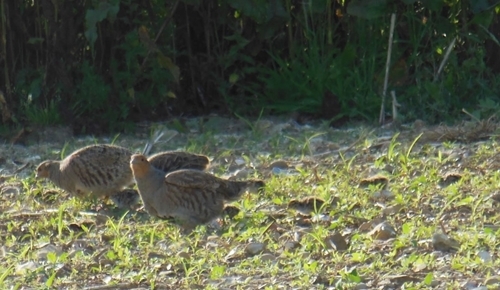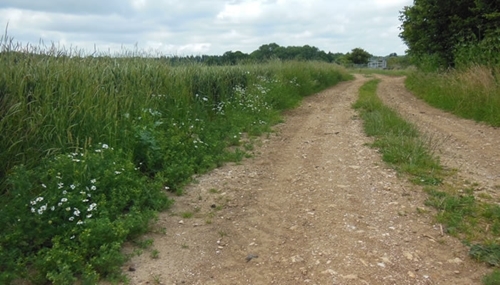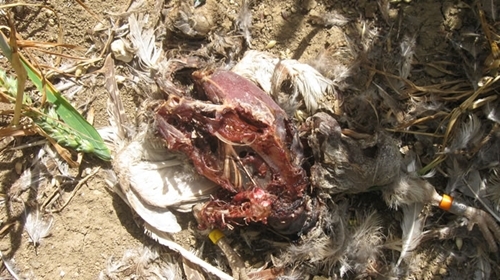by Francis Buner, Senior Conservation Scientist, GWCT
Last Friday we were fortunate to stumble across our second grey partridge brood at Rotherfield this season.
The reason for our sighting was because we were looking at our re-established wildbird seed mixes, together with John Davy the contractor and Tim Furbank from Oakbank Game & Conservation Ltd, who provides us with both seeds and advice on these mixes, but finding the partridges was a real bonus.

A pair of grey partridges with their three day old chicks, foraging on a re-drilled
wildbird mix along a third-year mix.
As luck would have it, this was the brood of the parent-reared pair that regularly visits my chicken feeder. Their leg ring combinations made any confusion impossible. We counted 10 three-day-old chicks, which seemed a bit odd, given that this was an early brood.
Grey partridges lay an average of 16 eggs here in the UK (no other bird in the world is known to have such big average clutch sizes) so there must have already been some losses during the first couple of days after hatching. Perhaps it was the kestrel that also killed one of the lapwing chicks earlier this season? Talking of which, the kestrel family is struggling themselves to get their brood through this year: out of four chicks, one died in the nest and one fell out before fledging, completely starved.
The area the partridges hatched off has plenty of excellent nesting cover but unfortunately no suitable brood-rearing cover nearby (breeding partridges typically have territories that are only 2ha in size).

Partridges regularly take their broods for foraging, dust bathing and sun bathing
on farm tracks during summer but unfortunately that exposes them to predators.
This is probably why I later observed them foraging on a dusty track along conventionally grown winter wheat, which is too thick and without any suitable insect food for a partridge brood. They ran another 100m down the track to reach another block of wildbird mix, of which half we just re-established in early June. This is where I managed to photograph them.
Two days later our doorbell rings and a rather sad looking Peter Rose (the estate’s keeper) holds a dead partridge under my nose. Its rings clearly identify it as ‘my’ garden cock, who became a father across the road just five days earlier. How annoying! (My real reaction was rather less polite!)

Grey partridge killed by sparrowhawk.
The signs of his injuries undoubtedly indicated a sparrowhawk kill. Should I therefore direct all my anger at the hawk? Well, not really, no. I suspect it was just too easy for him.
First, male and female partridge were reared and released, so their anti-predator behaviour may not have been 100% correct, even though they had been living in the wild for more than half a year. And second, the habitat was not 100% in their favour. We’ll have to get it right next year.
Today I saw the brood again. Sadly the number of chicks has now decreased to only four. Will any of them survive, I ask myself?
Well, maybe, as they just received some much-needed help: the hen is with what might look like her reincarnated partner if not for his different leg-rings, which identify him as a wild, translocated cock, now escorting her and her brood! Now that’s what I call real altruism (which is extremely rare in nature)!
How was that possible in such a short time and why would a partridge do such an incredible thing? Well, the first is easy to explain.
This lonely cock has been calling almost every evening around my house since spring, desperately trying to attract a female. Unluckily for him, there were not enough females around to please all the males, which is normal in partridge populations.
Now his fortunes had finally changed, as the female must have been calling to find her dead mate. Partridges look for their partners for about two days, after which they give up. So the widowed hen attracted the single male and that’s that. And what is in store for the male?
Well, if he and his new partner make it all the way through to next spring he has a major advantage: he doesn’t have to look for a female, which is extremely dangerous (up to 50% of cocks are either predated during the pairing period, disperse, or never find a partner). It’s certainly a tough life if you’re a grey partridge – and being a partridge conservationist isn’t easy either!